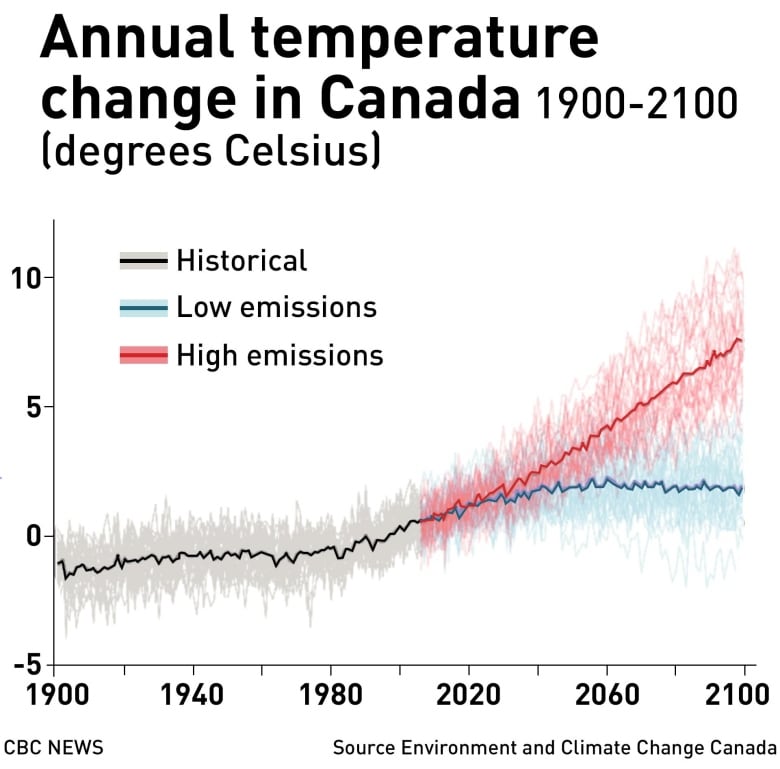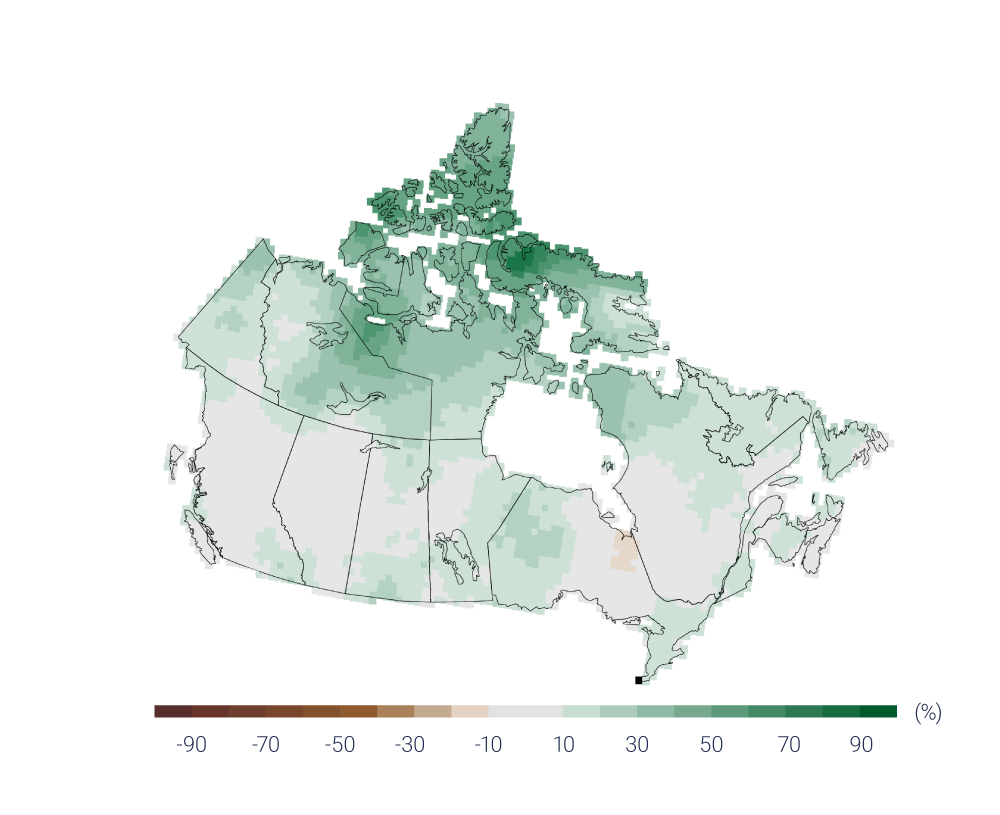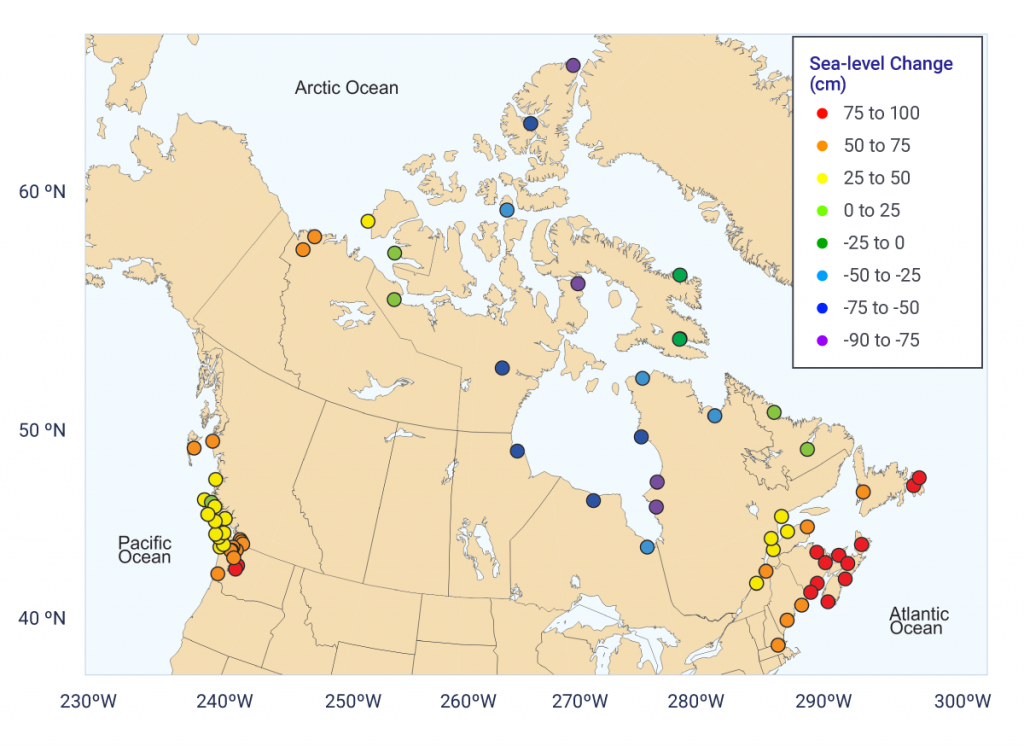Canada warming at twice the global rate, government report finds – “Northern Canada has warmed and will continue to warm at more than double the global rate”

1 April 2019 (CBC News) – Canada is, on average, experiencing warming at twice the rate of the rest of the world, with Northern Canada heating up at almost three times the global average, according to a new government report.
The study — Canada’s Changing Climate Report (CCCR) — was commissioned by Environment and Climate Change Canada. It says that since 1948, Canada’s annual average temperature over land has warmed 1.7 C, with higher rates seen in the North, the Prairies and northern British Columbia.
In Northern Canada, the annual average temperature has increased by 2.3 C.
According to the U.S. National Oceanic and Atmospheric Administration (NOAA), since 1948, global average temperatures have increased by about 0.8 C.
Along with these temperature increases, the CCCR says Canada is experiencing increases in precipitation (particularly in winter), “extreme fire weather” and water supply shortages in summer, and a heightened risk of coastal flooding.
The report was authored by government scientists from the ministries of Environment and Climate Change, Fisheries and Oceans and Natural Resources, with contributions from university experts.
The document says that while warming in Canada has been the result of both human activity and natural variations in the climate, “the human factor is dominant,” especially emissions of greenhouse gases. [more]
Canada warming at twice the global rate, leaked report finds
CCCR 2019 Headline Statements
Canada’s climate has warmed and will warm further in the future, driven by human influence. Global emissions of carbon dioxide from human activity will largely determine how much warming Canada and the world will experience in the future, and this warming is effectively irreversible. {2.3, 3.3, 3.4, 4.2}

Both past and future warming in Canada is, on average, about double the magnitude of global warming. Northern Canada has warmed and will continue to warm at more than double the global rate. {2.2, 3.3, 4.2}
Oceans surrounding Canada have warmed, become more acidic, and less oxygenated, consistent with observed global ocean changes over the past century. Ocean warming and loss of oxygen will intensify with further emissions of all greenhouse gases, whereas ocean acidification will increase in response to additional carbon dioxide emissions. These changes threaten the health of marine ecosystems. {2.2, 7.2, 7.6}
The effects of widespread warming are evident in many parts of Canada and are projected to intensify in the future. In Canada, these effects include more extreme heat, less extreme cold, longer growing seasons, shorter snow and ice cover seasons, earlier spring peak streamflow, thinning glaciers, thawing permafrost, and rising sea level. Because some further warming is unavoidable, these trends will continue. {4.2, 5.2, 5.3, 5.4, 5.5, 5.6, 6.2, 7.5}

Precipitation is projected to increase for most of Canada, on average, although summer rainfall may decrease in some areas. Precipitation has increased in many parts of Canada, and there has been a shift toward less snowfall and more rainfall. Annual and winter precipitation is projected to increase everywhere in Canada over the 21st century. However, reductions in summer rainfall are projected for parts of southern Canada under a high emission scenario toward the late century. {4.3}
The seasonal availability of freshwater is changing, with an increased risk of water supply shortages in summer. Warmer winters and earlier snowmelt will combine to produce higher winter streamflows, while smaller snowpacks and loss of glacier ice during this century will combine to produce lower summer streamflows. Warmer summers will increase evaporation of surface water and contribute to reduced summer water availability in the future despite more precipitation in some places. {4.2, 4.3, 5.2, 5.4, 6.2, 6.3, 6.4}
A warmer climate will intensify some weather extremes in the future. Extreme hot temperatures will become more frequent and more intense. This will increase the severity of heatwaves, and contribute to increased drought and wildfire risks. While inland flooding results from multiple factors, more intense rainfalls will increase urban flood risks. It is uncertain how warmer temperatures and smaller snowpacks will combine to affect the frequency and magnitude of snowmelt-related flooding. {4.2, 4.3, 4.4, 5.2, 6.2}
Canadian areas of the Arctic and Atlantic Oceans have experienced longer and more widespread sea-ice-free conditions. Canadian Arctic marine areas, including the Beaufort Sea and Baffin Bay, are projected to have extensive ice-free periods during summer by mid-century. The last area in the entire Arctic with summer sea ice is projected to be north of the Canadian Arctic Archipelago. This area will be an important refuge for ice-dependent species and an ongoing source of potentially hazardous ice, which will drift into Canadian waters. {5.3}

Coastal flooding is expected to increase in many areas of Canada due to local sea level rise. Changes in local sea-level are a combination of global sea level rise and local land subsidence or uplift. Local sea level is projected to rise, and increase flooding, along most of the Atlantic and Pacific coasts of Canada and the Beaufort coast in the Arctic where the land is subsiding or slowly uplifting. The loss of sea ice in Arctic and Atlantic Canada further increases the risk of damage to coastal infrastructure and ecosystem as a result of larger storm surges and waves. {7.5}
The rate and magnitude of climate change under high versus low emission scenarios project two very different futures for Canada. Scenarios with large and rapid warming illustrate the profound effects on Canadian climate of continued growth in greenhouse gas emissions. Scenarios with limited warming will only occur if Canada and the rest of the world reduce carbon emissions to near zero early in the second half of the century and reduce emissions of other greenhouse gases substantially. Projections based on a range of emission scenarios are needed to inform impact assessment, climate risk management, and policy development. {all chapters}